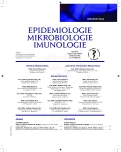Detection of biofilm formation by selected pathogens relevant to the food industry
Authors:
L. Šilhová-Hrušková; P. Moťková; D. Šilha; J. Vytřasová
Authors‘ workplace:
Katedra biologických a biochemických věd, Fakulta chemicko-technologická, Univerzita Pardubice
Published in:
Epidemiol. Mikrobiol. Imunol. 64, 2015, č. 3, s. 169-175
Category:
Original Papers
Overview
Objective:
Detection of biofilm formation by microbial pathogens relevant to the food industry and comparison of biofilm formation under different conditions of culture.
Material and methods:
The following microorganisms were selected for the study: Staphylococcus aureus, Listeria innocua, Listeria ivanovii, Cronobacter sakazakii, Cronobacter muytjensii, Arcobacter butzleri, Arcobacter cryaerophilus, Campylobacter jejuni, and Campylobacter coli. To detect biofilm formation the microtiter plate assay, as described by Christensen and culture on stainless steel coupons were used.
Results:
The biofilm forming capacity was confirmed in all microorganisms tested, both on the microtiter plates and stainless steel coupons. Biofilm formation was influenced by the culture medium, material used, and culture duration as well as by the test microorganism. It was found that different species and strains of the same genus differ in biofilm formation. Differences were also found between the collection strains and isolates from the environment. Some bacteria tended to form biofilm more readily on the surface of the polyethylene microtiter plates and less readily on stainless steel coupons while others appeared to have an opposite tendency. Some pathogens were able to increase the planktonic cell density in the initial suspension even by three orders of magnitude within 72 hours while producing plenty of biofilm.
Conclusions:
The study of biofilm formation by high risk pathogens is of utmost importance, not only to the food industry. From the obtained results, it is evident that bacterial biofilms form rapidly (within 24 hours in the present study). Due to their architecture, these biofilms are difficult to eradi-cate, and therefore, it is crucial to prevent biofilm formation.
Keywords:
stainless steel – biofilm – pathogens – planktonic cells – microtiter plate
Sources
1. Schlegelová J, Karpíšková S. Mikrobiální biofilmy v potravinářském průmyslu. Epidemiol Mikrobiol Imunol, 2007;56 : 14–19.
2. Trachoo N. Biofilms and the food industry. Songklanakarin J Sci Technol, 2003;25 : 807–815.
3. Sanz-Lázaro C, Navarrete-Mier F, Marín A. Biofilm responses to marine fish farm wastes. Environ Pollut, 2011;159 : 825–832.
4. Chmielewski RAN, Frank JF. Biofilm formation and control in food processing facilities. Compr Rev Food Sci F, 2003;2 : 22–32.
5. Lindsay D, Von Holy A. What food safety professional should know about bacterial biofilm. Brit Food J, 2006;108 : 27–37.
6. De Lancey Pulcini E. Bacterial biofilms: a review of current research. Nephrologie, 2001;22 : 439–441.
7. Růžička F, Holá V, Votava M. Možnosti průkazu tvorby biofilmu v rutinní mikrobiologické praxi. Epidemiol Mikrobiol Imunol, 2006;55 : 23–29.
8. Černohorská L, Sláviková P. Pseudomonas aeruginosa, její rezistence k vybraným antibiotikům a tvorba biofilmu u kmenů izolovaných od pacientů s infekcí močových cest. Epidemiol Mikrobiol Imunol, 2009;58 : 154–157.
9. Kjeldgaard J, Jørgensen K, Ingmer H. Growth and survival at chiller temperatures of Arcobacter butzleri. Int J Food Microbiol, 2009;131 : 256–259.
10. Van Houdt R, Michiels CW. Biofilm formation and the food industry, a focus on the bacterial outer surface. J Appl Microbiol, 2010;109 : 1117–1131.
11. Kumar A, Prasad R. Biofilms. JK Science, 2006;8 : 14–17.
12. Brooks JD, Flint SH. Biofilms in the food industry: problems and potential solutions. Int J Food Sci Tech, 2008;2 : 2163–2176.
13. Piskernik S, Klančnik A, Riedel CT et al. Reduction of Campylo-bacter jejuni by natural antimicrobials in chicken meat-related conditions. Food Control, 2011;22 : 718–724.
14. Douidah L, De Zutter L, Vandamme, P, et al. Identification of five human and mammal associated Arcobacter species by a novel multiplex-PCR assay. J Microbiol Meth, 2010;80 : 281–286.
15. Phillips CA. Arcobacter spp. in food: isolation, identification and control. Trends Food Sci Tech, 2001;12 : 263–275.
16. Demnerová K, Pazlarová J. Enterobacter sakazakii alias Cronobacter sakazakii – Nová hrozba? Chem Listy, 2009;103 : 641–646.
17. Strydom A, Cawthorn DM, Cameron M, et al. Species of Cronobacter – A review of recent advances in the genus and their significance in infant formula milk. Int Dairy J, 2012;27 : 3–12.
18. Hood SK, Zottola EA. Biofilms in food processing. Food Control, 1995;6 : 9–18.
19. Mah TFC, O´Toole GA. Mechanisms of biofilm resistance to antimicrobial agents. Trends Microbiol, 2001;9 : 34–39.
20. Du XJ, Wang F, Lu X et al. Biochemical and genetic characteristics of Cronobacter sakazakii biofilm formation. Res Microbiol, 2012;163 : 448–456.
21. Purkrtová S, Pilchová T, Ďurišová J, et al. Podmínky tvorby biofilmu u Listeria monocytogenes. Mlékařské listy, 2009;12 : 12–15.
22. Djordjevic D, Wiedmann M, McLandsborough LA. Microtiter plate assay for assessment of Listeria monocytogenes biofilm formation. Appl Environ Microb, 2002;68 : 2950–2958.
23. Stepanović S, Vuković D, Dakić I, et al. A modified microtiter-plate test for quantification of staphylococcal biofilm formation. J Microbiol Meth, 2000;40 : 175–179.
24. Ferreira F, Fraqueza MJ, Queiroz JA, et al. Genetic diversity, antibiotic resistance and biofilm-forming ability of Arcobacter butzleri isolated from poultry and environment from a Portuguese slaughterhouse. Int J Food Microbiol, 2013;162 : 82–88.
25. Teh KH, Flint S, French N. Biofilm formation by Campylobacter jejuni in controlled mixed-microbial populations. Int J Food Microbiol, 2010;143 : 118–124.
26. Blackman IC, Frank JF. Growth of Listeria monocytogenes as a biofilm on various food-processing surfaces. J Food Protect, 1996;59 : 827–831.
27. Gough NL, Dodd CER. The survival and disinfection of Salmonella typhimurium on chopping board surfaces of wood and plastic. Food Control, 1998;6 : 363–368.
Labels
Hygiene and epidemiology Medical virology Clinical microbiologyArticle was published in
Epidemiology, Microbiology, Immunology

2015 Issue 3
Most read in this issue
- Human prion diseases in the Czech Republic
- Ganciclovir treatment failure in adult allogeneic hematopoietic stem cell transplant recipients with cytomegalovirus infection – a single centre experience
- Genetic and molecular background in autoimmune diabetes mellitus
- Detection of biofilm formation by selected pathogens relevant to the food industry
